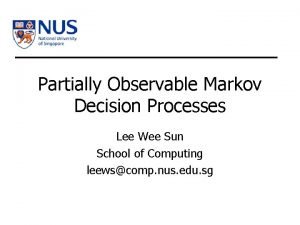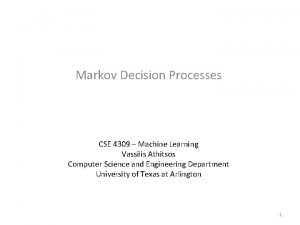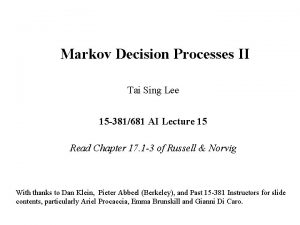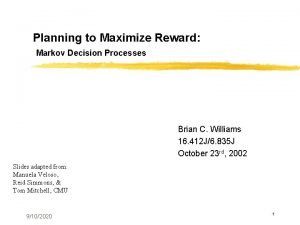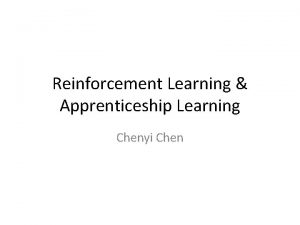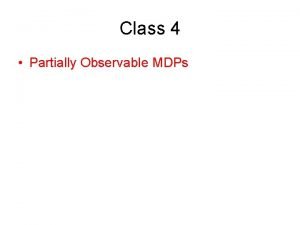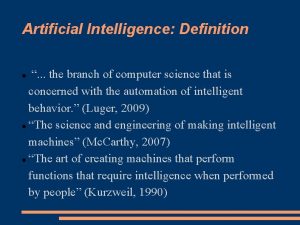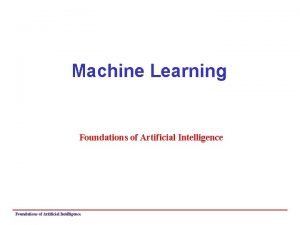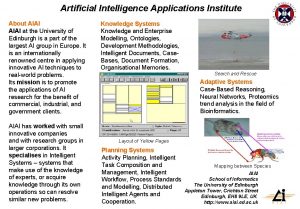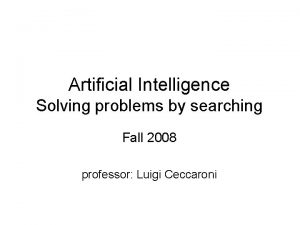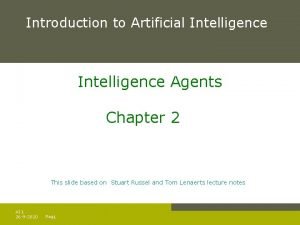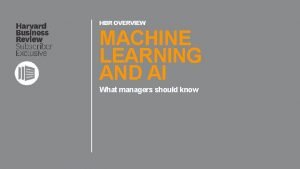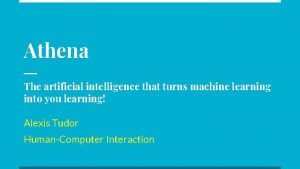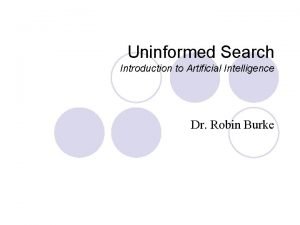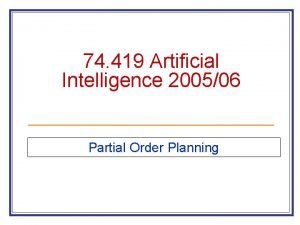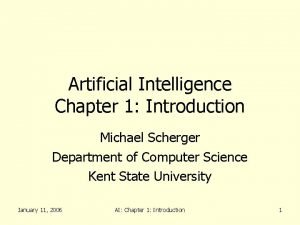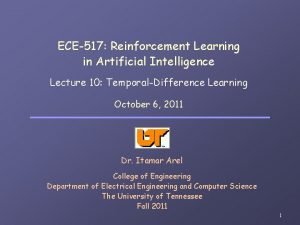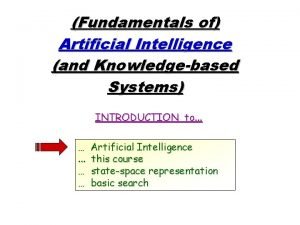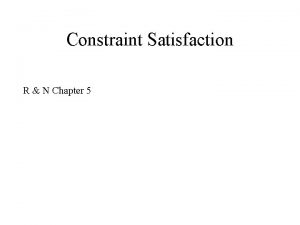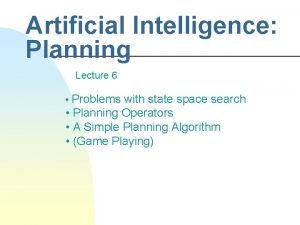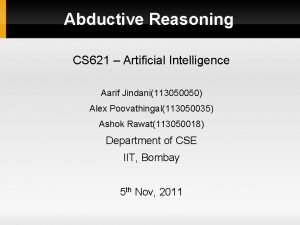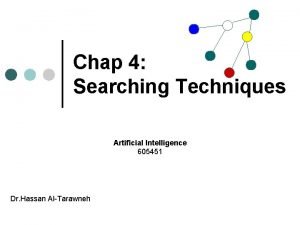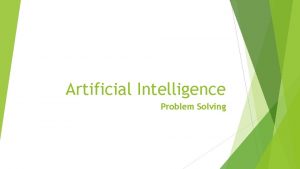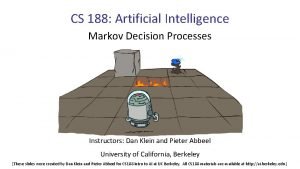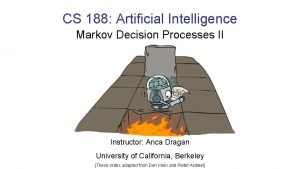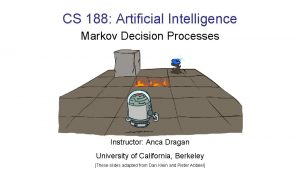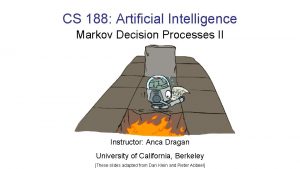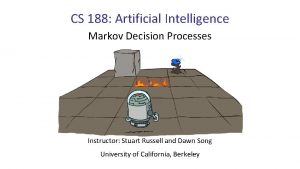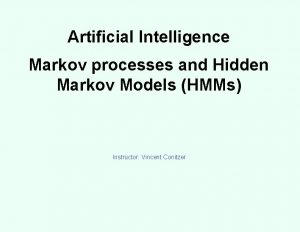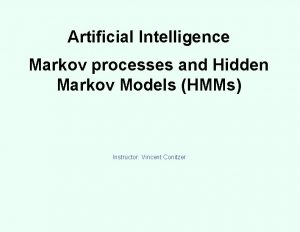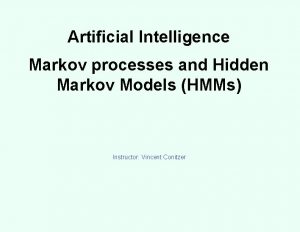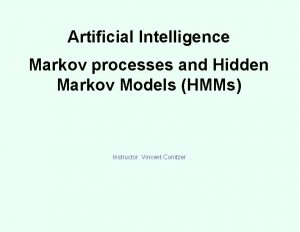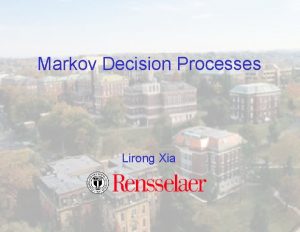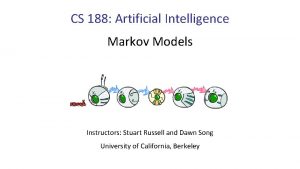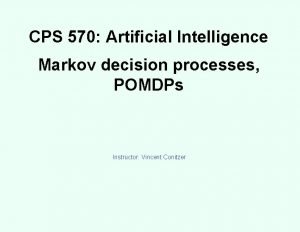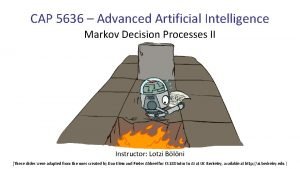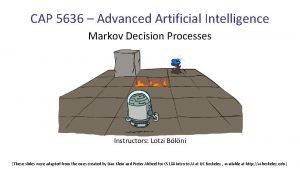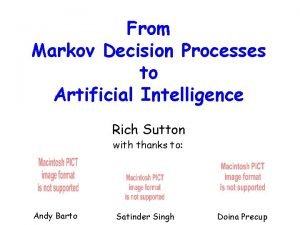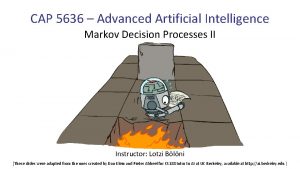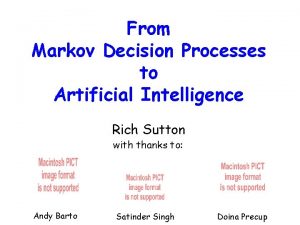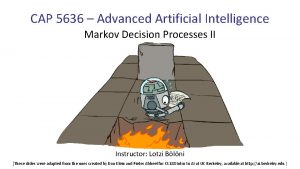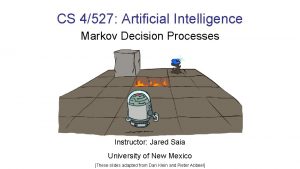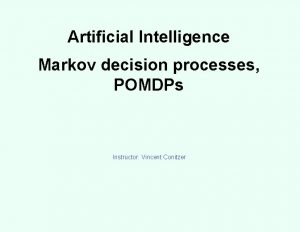CS 188 Artificial Intelligence Markov Decision Processes II
















































- Slides: 48

CS 188: Artificial Intelligence Markov Decision Processes II Instructor: Nikita Kitaev --- University of California, Berkeley [Slides adapted from Dan Klein and Pieter Abbeel (ai. berkeley. edu). ]

Example: Grid World § A maze-like problem § § The agent lives in a grid Walls block the agent’s path § Noisy movement: actions do not always go as planned § § § 80% of the time, the action North takes the agent North 10% of the time, North takes the agent West; 10% East If there is a wall in the direction the agent would have been taken, the agent stays put § The agent receives rewards each time step § § Small “living” reward each step (can be negative) Big rewards come at the end (good or bad) § Goal: maximize sum of (discounted) rewards

Recap: MDPs § Markov decision processes: § § § States S Actions A Transitions P(s’|s, a) (or T(s, a, s’)) Rewards R(s, a, s’) (and discount ) Start state s 0 § Quantities: § § s a s, a, s’ Policy = map of states to actions Utility = sum of discounted rewards Values = expected future utility from a state (max node) Q-Values = expected future utility from a q-state (chance node) s’

Optimal Quantities § The value (utility) of a state s: V*(s) = expected utility starting in s and acting optimally s s is a state a § The value (utility) of a q-state (s, a): Q*(s, a) = expected utility starting out having taken action a from state s and (thereafter) acting optimally § The optimal policy: *(s) = optimal action from state s (s, a) is a q-state s, a, s’ s’ (s, a, s’) is a transition

Gridworld Values V*

Gridworld: Q*

The Bellman Equations How to be optimal: Step 1: Take correct first action Step 2: Keep being optimal

The Bellman Equations § Definition of “optimal utility” via expectimax recurrence gives a simple one-step lookahead relationship amongst optimal utility values s a s, a, s’ s’ § These are the Bellman equations, and they characterize optimal values in a way we’ll use over and over

Value Iteration § Bellman equations characterize the optimal values: V(s) a s, a, s’ § Value iteration computes them: § Value iteration is just a fixed point solution method § … though the Vk vectors are also interpretable as time-limited values V(s’)

Convergence* § How do we know the Vk vectors are going to converge? § Case 1: If the tree has maximum depth M, then VM holds the actual untruncated values § Case 2: If the discount is less than 1 § Sketch: For any state Vk and Vk+1 can be viewed as depth k+1 expectimax results in nearly identical search trees § The difference is that on the bottom layer, Vk+1 has actual rewards while Vk has zeros § That last layer is at best all RMAX § It is at worst RMIN § But everything is discounted by γk that far out § So Vk and Vk+1 are at most γk max|R| different § So as k increases, the values converge

Policy Methods

Policy Evaluation

Fixed Policies Do the optimal action Do what says to do s s a (s) s, a s, (s) s, a, s’ s, (s), s’ s’ s’ § Expectimax trees max over all actions to compute the optimal values § If we fixed some policy (s), then the tree would be simpler – only one action per state § … though the tree’s value would depend on which policy we fixed

Utilities for a Fixed Policy § Another basic operation: compute the utility of a state s under a fixed (generally non-optimal) policy s (s) § Define the utility of a state s, under a fixed policy : s, (s) V (s) = expected total discounted rewards starting in s and following s, (s), s’ § Recursive relation (one-step look-ahead / Bellman equation): s’

Example: Policy Evaluation Always Go Right Always Go Forward

Example: Policy Evaluation Always Go Right Always Go Forward

Policy Evaluation § How do we calculate the V’s for a fixed policy ? s (s) § Idea 1: Turn recursive Bellman equations into updates (like value iteration) s, (s), s’ s’ § Efficiency: O(S 2) per iteration § Idea 2: Without the maxes, the Bellman equations are just a linear system § Solve with Matlab (or your favorite linear system solver)

Policy Extraction

Computing Actions from Values § Let’s imagine we have the optimal values V*(s) § How should we act? § It’s not obvious! § We need to do a mini-expectimax (one step) § This is called policy extraction, since it gets the policy implied by the values

Computing Actions from Q-Values § Let’s imagine we have the optimal q-values: § How should we act? § Completely trivial to decide! § Important lesson: actions are easier to select from q-values than values!

Policy Iteration

Problems with Value Iteration § Value iteration repeats the Bellman updates: s a s, a § Problem 1: It’s slow – O(S 2 A) per iteration s, a, s’ § Problem 2: The “max” at each state rarely changes § Problem 3: The policy often converges long before the values s’

k=0 Noise = 0. 2 Discount = 0. 9 Living reward = 0

k=1 Noise = 0. 2 Discount = 0. 9 Living reward = 0

k=2 Noise = 0. 2 Discount = 0. 9 Living reward = 0

k=3 Noise = 0. 2 Discount = 0. 9 Living reward = 0

k=4 Noise = 0. 2 Discount = 0. 9 Living reward = 0

k=5 Noise = 0. 2 Discount = 0. 9 Living reward = 0

k=6 Noise = 0. 2 Discount = 0. 9 Living reward = 0

k=7 Noise = 0. 2 Discount = 0. 9 Living reward = 0

k=8 Noise = 0. 2 Discount = 0. 9 Living reward = 0

k=9 Noise = 0. 2 Discount = 0. 9 Living reward = 0

k=10 Noise = 0. 2 Discount = 0. 9 Living reward = 0

k=11 Noise = 0. 2 Discount = 0. 9 Living reward = 0

k=12 Noise = 0. 2 Discount = 0. 9 Living reward = 0

k=100 Noise = 0. 2 Discount = 0. 9 Living reward = 0

Policy Iteration § Alternative approach for optimal values: § Step 1: Policy evaluation: calculate utilities for some fixed policy (not optimal utilities!) until convergence § Step 2: Policy improvement: update policy using one-step look-ahead with resulting converged (but not optimal!) utilities as future values § Repeat steps until policy converges § This is policy iteration § It’s still optimal! § Can converge (much) faster under some conditions

Policy Iteration § Evaluation: For fixed current policy , find values with policy evaluation: § Iterate until values converge: § Improvement: For fixed values, get a better policy using policy extraction § One-step look-ahead:

Comparison § Both value iteration and policy iteration compute the same thing (all optimal values) § In value iteration: § Every iteration updates both the values and (implicitly) the policy § We don’t track the policy, but taking the max over actions implicitly recomputes it § In policy iteration: § We do several passes that update utilities with fixed policy (each pass is fast because we consider only one action, not all of them) § After the policy is evaluated, a new policy is chosen (slow like a value iteration pass) § The new policy will be better (or we’re done) § Both are dynamic programs for solving MDPs

Summary: MDP Algorithms § So you want to…. § Compute optimal values: use value iteration or policy iteration § Compute values for a particular policy: use policy evaluation § Turn your values into a policy: use policy extraction (one-step lookahead) § These all look the same! § They basically are – they are all variations of Bellman updates § They all use one-step lookahead expectimax fragments § They differ only in whether we plug in a fixed policy or max over actions

Double Bandits

Double-Bandit MDP § Actions: Blue, Red § States: Win, Lose 0. 25 W $0 0. 75 $2 0. 25 $0 $1 1. 0 No discount 100 time steps Both states have the same value 0. 75 $2 L $1 1. 0

Offline Planning § Solving MDPs is offline planning No discount 100 time steps Both states have the same value § You determine all quantities through computation § You need to know the details of the MDP § You do not actually play the game! 0. 25 Value Play Red Play Blue 150 100 $1 1. 0 W 0. 75 $2 0. 75 $0 0. 25 $0 $2 L $1 1. 0

Let’s Play! $2 $2 $0 $0 $0

Online Planning § Rules changed! Red’s win chance is different. ? ? W $0 ? ? $2 ? ? $0 $1 1. 0 ? ? $2 L $1 1. 0

Let’s Play! $0 $0 $0 $2 $0 $0

What Just Happened? § That wasn’t planning, it was learning! § Specifically, reinforcement learning § There was an MDP, but you couldn’t solve it with just computation § You needed to actually act to figure it out § Important ideas in reinforcement learning that came up § § § Exploration: you have to try unknown actions to get information Exploitation: eventually, you have to use what you know Regret: even if you learn intelligently, you make mistakes Sampling: because of chance, you have to try things repeatedly Difficulty: learning can be much harder than solving a known MDP

Next Time: Reinforcement Learning!
 Markov decision process puterman
Markov decision process puterman No decision snap decision responsible decision
No decision snap decision responsible decision Dividend decision in financial management
Dividend decision in financial management Lee wee sun
Lee wee sun Markov decision
Markov decision Value iteration
Value iteration Markov decision
Markov decision Value iteration
Value iteration Mdp example
Mdp example Markov decision
Markov decision Markov decision process merupakan tuple dari
Markov decision process merupakan tuple dari Concurrent in os
Concurrent in os Artificial intelligence devices
Artificial intelligence devices Artificial intelligence is a branch of computer science
Artificial intelligence is a branch of computer science Aima slides
Aima slides Unit 7 artificial intelligence
Unit 7 artificial intelligence Rote learning in artificial intelligence
Rote learning in artificial intelligence Artificial intelligence applications institute
Artificial intelligence applications institute Artificial intelligence for class 6
Artificial intelligence for class 6 What is the alan turing test
What is the alan turing test Artificial intelligence chapter 1
Artificial intelligence chapter 1 Solving problems by searching artificial intelligence
Solving problems by searching artificial intelligence Peas example in ai
Peas example in ai Mycin architecture
Mycin architecture Artificial probing chapter 2
Artificial probing chapter 2 15-780 graduate artificial intelligence
15-780 graduate artificial intelligence Space complexity bfs
Space complexity bfs Csc 450
Csc 450 Hbr machine learning
Hbr machine learning Athena artificial intelligence
Athena artificial intelligence Uninformed search in artificial intelligence
Uninformed search in artificial intelligence Artificial intelligence thesis proposals
Artificial intelligence thesis proposals Partial order planning in artificial intelligence
Partial order planning in artificial intelligence Cse 571 artificial intelligence
Cse 571 artificial intelligence Artificial intelligence chapter 1
Artificial intelligence chapter 1 Passive reinforcement learning in artificial intelligence
Passive reinforcement learning in artificial intelligence Kecerdasan kepemimpinan
Kecerdasan kepemimpinan Fundamentals of artificial intelligence
Fundamentals of artificial intelligence Waltz algorithm in artificial intelligence
Waltz algorithm in artificial intelligence Artificial intelligence devices
Artificial intelligence devices Mobedic
Mobedic Planning in artificial intelligence
Planning in artificial intelligence Water jug problem production rules
Water jug problem production rules Cpsc 322: introduction to artificial intelligence
Cpsc 322: introduction to artificial intelligence Artificial intelligence class 8 chapter 3 solutions
Artificial intelligence class 8 chapter 3 solutions Artificial intelligence
Artificial intelligence Searching techniques in artificial intelligence
Searching techniques in artificial intelligence Artificial intelligence
Artificial intelligence 15-780 graduate artificial intelligence
15-780 graduate artificial intelligence



